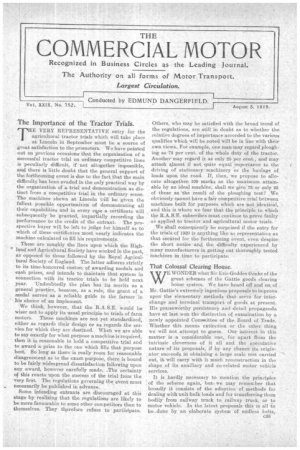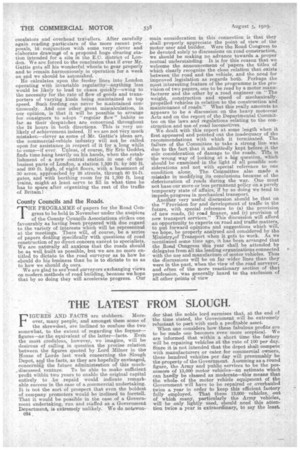That Colossal Clearing House.
Page 1

Page 2

If you've noticed an error in this article please click here to report it so we can fix it.
WE WONDER what Sir Erie Geddes thinks of the great schemes of the Gattie goods clearing house system. We have heard off and on of Mr. Gattie's extremely ingenious proposals to improve upon the elementary methods that serve for interchange and terminal transpert of goods at present. His praiseworthy persistency and detail propaganda have at last won the distinction of examination by a newly appointed Committee of the Board of Trade. Whether this means extinction or the other thing -we will not attempt to guess. Our interest in this matter is a considerable one,1 for apart from the intrinsic cleverness of it all and the speculative nature of its proposals, if by any chance its origin. atm. succeeds in obtaining a large scale test carried out, it will carry with it much reconstruction in the shape of its auxiliary and co-related motor vehicle services. . It is hardly necessary to mention the principles , -of the scheme again, but we may remermber that • broadly it consists of the adoption of methods for dealing with unit bulk loads and for transferring them bodily from railway truck to railway truck, or to motor vehicle. In the latest proposals this is all to bedone by an elaborate system of endless belts, escalators and overhead travellers. After carefully again reading .particulars of the more recent proposals, in. conjunction with some very clever and elaborate drawings of a proposed huge clearing station intended for a site in the E.C. district of London. We are forced to the conclusion that if ever Mr. G'ittie gets all his wonderful wheels to gear properly and to remain harmoniously in operation for a week on end we should be 'astonished. He calculates upon the feeder lines into London operating with invariable regularity—anything less would be likely to lead to chaos quickly—owing to the necessity for the rate of flow of goods and transporters of varying kinds being maintained at top speed. Such feeding can never be maintained continuously. And one other great miscalculation, in. our opinion, is that it will be possible to arrange for coasignors to adopt "regular flow" habits so far as their despatches are concerned throughout the 24 hours in both directions. This is very unlikely of achievement indeed. If we are not very much mistaken—clever as some of Mr. Gattie's ideas are, the commercial-vehicle industry will not be called upon for assistance in respect of it for a long while to come—if ever. Unless, of course, Sir Erie Geddes finds time hang heavily on his hands, when the establishment of a new central station in one of the busiest parts of London, a station 1,320 ft. by 560 ft. and 200 ft. high, of eight floors, with a basement of 30 acres, approached by 26 streets, through 60 24-ft. gates, and with berthing room for 24 1,300 ft. long trains, might at least serve to fill in what time he has to spare after organizing the rest of the traffic of Britain!






















